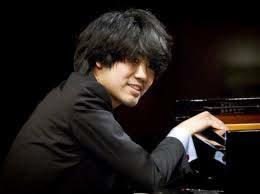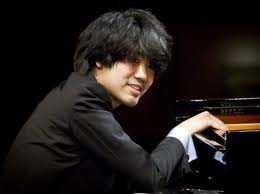
The quadrennial Van Cliburn International Piano Competition, in Fort Worth, Texas, took place earlier this year, and the three medalists have been on international tours since. The first medalist to perform in California was to be the gold medal winner, Vadym Kholodenko, under the auspices of the Steinway Society of the Bay Area at DeAnza College, Cupertino.
But Kholodenko’s tour was abruptly interrupted when he fell ill after his recital in Fort Worth earlier in the week, requiring an emergency surgery.
His co-medal winner, Sean Chen, who currently lives in Connecticut, came to the rescue. A California native, and the first American to win a medal since Jon Nakamatsu in 1997, Chen had earned a reputation for his approachable personality and showmanship. While Kholodenko fans were clearly disappointed, the audience was in for a treat.
Chen assembled an extravagant collection of dance-inspired music, and began his recital with an intimate, whimsical rendition of J.S. Bach’s Fifth French Suite in G Major. In a performance that he liberally laced with smile-inducing ornamentations, Chen assigned varied colors and characters to each of the lines, evoking an ensemble performance by several musicians and thus bringing spontaneity and freshness to each of the dances. The incessant gigue/fugue was remembered as a piece that Chen performed when young, and was delivered with youthful energy and charm.
Following the Bach came a trio of works by Alexander Scriabin. Chen began with an indulgently sentimental reading of Valse, Op. 38. The vague three-quarter rhythm was often hidden under quadruplets and quintuplets, which implied languid stupor and illustrated the euphoria of an artist under the influence of some unmentionable substance, as Chen suggested while introducing the piece.
The fourth sonata, Op. 30, came out somewhat hesitant and haltingly slow, though the two movements are marked Andante and Prestissimo volando, respectively. I yearned for a more exuberant crescendo of excitement, not just in the triumphant coda, but also throughout the work. The piece’s character, as performed, seemed a bit shy and timid, though in the coda Chen finally delivered ecstatically the lovingly yearning theme from the first movement, in a storm of massive chords that filled the air.
Chen built on that fourth sonata by delivering a triumphant, explosive rendition of the fifth sonata, Op. 53. From the rumbling earthquake-like opening, the reading was visceral, volatile, and even carnal. The extreme contrasts and frequent maniacal transitions were both transcendental and violent, depicting the volcanic eruptions of ecstasy to the stillness of la petite mort so vividly. Chen truly encapsulated the excitement that the composer must have experienced while composing the work in only six days.
Chen truly encapsulated the excitement that the composer must have experienced while composing the work in only six days. The second half of the concert was dedicated entirely to compositions by Maurice Ravel, all written in three-quarter time. Valses nobles et sentimentales was brought forth with much attention to the clockwork-like intricacy of Ravel’s writing, which is full of rich counterpoints and extended chords and a harmonic structure that later heavily influenced jazz musicians. From the exquisitely naive waltz No. 3 to the reflective epilogue, myriad scenes and characters were illustrated by Chen’s delicate and deft hands, while evoking nostalgia for a long-ago era.
Chen continued to indulge his audience with another trio of Ravel works: Prélude, Menuet sur le nom d’Haydn, and Menuet antique. The brief Prélude, which barely lasts a minute, was composed for a sight-reading test at the Paris Conservatoire, and showed off Chen’s keen understanding of the composer’s artistry. Extended chords bloomed with rich harmonics, even with so few notes. Ravel’s profound influence on jazz was especially evident in Prélude and Menuet antique. Chen was not shy about expressing that influence, and he also showed off Ravel’s wit in Menuet sur le nom d’Haydn with élan.
The effect was richer than we are used to hearing, and the additional layered details added vibrant orchestral colors. Continuing the theme of the three-quarter rhythm, finishing the recital with the famous La Valse was inevitable, given its scale and drama. Chen upped the ante by presenting his own transcription of the piece, filling in some of the details that Ravel had left out in his own transcription from the original orchestral version. Chen lovingly explained the process from the first time he heard the piece in Aspen in 2005, discovering the composer’s piano solo transcription, then feeling the loss of the grandeur and extravagance that was missing from that transcription. Chen even sheepishly admitted that “it’s really difficult,” and that if he kept taking out more of the parts that are hard to perform he might end up with Ravel’s own transcription. With a disclaimer that it’s not all about accuracy, Chen dove into the hot water fearlessly.
The effect was richer than we are used to hearing, and the additional layered details added vibrant orchestral colors. Comparing Chen’s transcription to Ravel’s own may be like comparing Vladimir Horowitz’s arrangement of Franz Liszt’s Hungarian Rhapsody No. 2 to Liszt’s original: full of audacity, bravura, and showmanship. While a few of the octave passages may have robbed the music of some of the fluidity of the twirling dancers, the extravagant rendition of the haunting scene in Vienna reminded me that war was raging throughout Europe at the time. The destruction of civilization, depicted in the end, engulfed the moment with both triumph and terror.
Even after the exultant La Valse, Chen wasn’t finished. Still seemingly high on performance adrenaline, Chen offered three encores. Continuing his extraordinary showmanship, he improvised on the Andante spianato from Chopin's Grande Polonaise Brilliante. Witnessing Chen migrate from Chopin to his own world, while incorporating Chopin’s vocabulary, was a rare, fascinating event. Improvisation was popular in the Romantic period, and it made me pause to think what it might have been like to hear Liszt himself improvise. Chen also offered a “real” Chopin, the Impromptu, No. 1, Op. 29, and then concluded the evening with a little morsel that he described as “14 measures,” which I suspect may have been his own creation.

